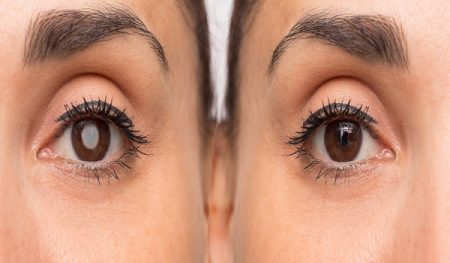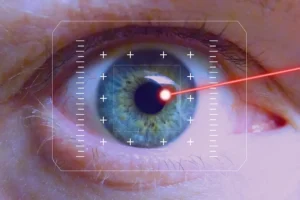Types of Cataracts
- Updated on: Jul 5, 2024
- 6 min Read
- Published on Feb 27, 2020

Cataracts are dense and cloudy areas that form in the eyes and lead to opacification of the eye lens. Cataracts begin when proteins in the eyes form clumps that send wrong or unclear images to the retina leading to blurry vision.
People who have cataracts in their eyes feel as if they are looking through a frosty or fogged-up window due to cloudy lenses.
What are the Different Types of Cataracts?
There are several types of cataracts based on the origin and location of cataracts in the eyes.
Types of Cataracts Based on Location
Cataracts in the eyes are mostly formed in three basic areas of the natural eye lens:
- the center of the eye lens
- the outer portion of the lens, and
- the back surface of the lens
Therefore, cataracts are classified into the following types accordingly based on their locations in the eye lens:
- Cataracts affecting the central part of the lens (nuclear cataracts)
- Cataracts affecting the outer edges of the lens (cortical cataracts)
- Cataracts affecting the back surface of the lens (posterior subcapsular cataracts)
Nuclear Cataracts or Nuclear Sclerotic Cataracts
These are the most common types of cataracts that are formed in the middle or central part of the eye lens. Since these cataracts affect the center of the lens called a nucleus that is why they are called nuclear cataracts.
Nuclear cataracts harden the middle part of the eye lens and then turn it into a yellow or brown color. With time these cataracts get worse and affect the patient’s ability of reading, seeing colors, seeing small objects, etc. Besides, patients suffering from these types of cataracts see halos (bright circles) around bright objects during the night.
Etiology of Nuclear Cataracts
Nuclear cataracts cause yellowing and hardening of the central portion (nucleus) of the eye lens. Hardening of the core of lens increases the refractive power of the lens and results in nearsightedness (inability to see far-off objects).
Symptoms of Nuclear Cataracts
Patients with nuclear cataracts may show the following symptoms:
- Blurry vision
- Poor vision during night
- Glare
- Increased myopia
- Monocular diplopia
Cortical Cataracts
Cataracts belonging to this category are wedge-shaped and usually form around the outer edges of the nucleus of the eye lens. These cataracts develop on the outer edges of the lens called the cortex, and are therefore named as cortical cataracts.
Initially, these cataracts appear as white wedges, triangular pointing towards the center of the eye. Later, as they grow, they cause scattering of the light. People suffering from these cataracts have difficulty in differentiating colors and seeing far away objects.
These cataracts make vision hazy and the patient feels as if he/she is looking through a fog. Since these cataracts affect both nearby and distant vision, they should be removed as early as possible.
Symptoms of Cortical Cataracts
People suffering from cortical cataracts show the following symptoms:
- Glare (the most common and predominant symptom)
- Reduced nearby vision
- Decreased distant vision
- Reduced contrast sensitivity
Posterior Capsular Cataracts
Posterior capsular cataracts develop at the back surface of the eye lens and are formed rapidly compared to the other two types of cataracts (nuclear and cortical cataracts). These cataracts are formed at the back of the lens capsule (a portion of the eye that surrounds the lens and keeps it in place) and comes directly in the path of light as it enters the lens.
Posterior capsular cataracts form rapidly and the patients observe symptoms within months. Mostly younger people are affected by these types of cataracts. These cataracts can affect your nearby vision and also makes it difficult for you to see in bright lighting.
Symptoms of Posterior Capsular Cataracts
People with posterior capsular cataracts present following symptoms:
- Glare
- More difficulty in close-up vision than distant vision, however, some people notice the opposite
- Rapidly decreased vision
All these three types of cataracts can be treated with cataract surgery. Read about cataract treatment.
Other Types of Cataracts
There are some other types of cataracts that are formed in the eye lens.
Senile or Age-Related Cataracts
These types of cataracts are mostly found in elderly people between 70 to 80 years of age but the symptoms may appear at early age as well.
In the early stages, the senile or age-related cataracts increase the power of the lens and cause myopia (near-sightedness). Later the lens becomes opacified and yellow colored which reduces the perception of blue colors. This condition usually affects both eyes, but in the early stages, only one eye gets affected and more severely than the other.
Initially, the age-related cataracts are characterized by lens opacity followed by swelling in the lens and, finally shrinkage of the lens with complete loss of transparency. The condition in the later stages causes liquefaction of the cataract cortex to form a milky white fluid in a Morgagnian cataract (a condition where the cortex becomes entirely liquefied and the nucleus sinks inferiorly), which leads to severe inflammation if the lens capsule ruptures and leaks.
Untreated senile cataracts may cause phacomorphic glaucoma. The majority of age-related cataracts are caused due to clumping of the proteins typically around the central (nucleus) portion of the lens which gradually increases in size leading to dull or blur vision.
Anterior Subcapsular Cataracts
These types of cataracts are formed just in front of the lens capsule mostly due to an injury or swelling in the eye.
Congenital Cataracts
These cataracts are either present right from birth or develop during a baby’s first year. These cataracts are less common compared to age-related cataracts.
Secondary Cataracts or Posterior Capsule Opacification
Secondary cataracts are formed due to some diseases (glaucoma and diabetes) or medications (steroids like prednisone or other drugs). Since these cataracts are formed due to other medical conditions or medical treatments, they are called secondary cataracts.
Secondary cataracts are common but can be treated with laser treatment. Secondary cataracts are not real cataracts because they are formed outside the lens rather than inside, but the vision problems caused by them are similar to original cataracts formed inside the lens.
The majority of people who have undergone cataract surgery develop secondary cataracts. Secondary cataracts can be treated easily and quickly with the help of laser treatment and people usually regain their normal vision within a few days after the procedure.
Traumatic Cataracts
The traumatic cataracts are caused due to some kind of injury to the eye. These cataracts either develop immediately after the injury or do not show up until years later.
Different types of injuries can lead to traumatic cataracts such as blunt or penetrating eye injuries, injuries due to electrocution, injuries due to chemical burns, and injuries due to exposure to radiations, etc.
Traumatic cataracts cause clouding of the eye lens at the site of injury which may later extend to the entire lens resulting in various vision problems.
Radiation Cataracts
These types of cataracts are caused due to exposure to UV radiation. These cataracts are also a possible side effect of radiation therapy for cancer. These cataracts can be prevented by avoiding exposure to UV radiation.
Lamellar or Zonular Cataracts
These cataracts are typically found in younger children due to some genes inherited from their parents. They generally affect both the eyes and form some white-colored dots in the middle lens that may take on a Y shape. Later, these white dots spread into the entire lens and turns it white.
Posterior Polar Cataracts
These cataracts are congenital cataracts caused due to some genes inherited from the parents. These are formed on the back center of the eye lens and are often asymptomatic and very difficult to remove.
Anterior Polar Cataracts
These cataracts are harmless and do not impair your vision. They are formed in the front and center of the eye lens and appear like small white dots.
Post-Vitrectomy Cataracts
Vitrectomy is the surgical removal of a vitreous membrane (clear gel present at the center of eyes) of eyes. It is performed for treating certain eye disorders. After this surgery, some people develop cataracts called post-vitrectomy cataracts.
Christmas Tree Cataracts or Polychromatic Cataracts
These cataracts are mostly found in people suffering from a condition called myotonic dystrophy (a genetic condition that affects the muscle function). They form shiny, colored crystals in your eye lens.
Brunescent Cataracts
These are caused due to untreated nuclear cataracts. If nuclear cataracts are left untreated, they become harder and brown colored and are called brunescent cataracts.
Patients suffering from these cataracts are unable to differentiate between different colors especially blues and purples.
Diabetic Snowflake Cataracts
These are rare types of cataracts that may develop in diabetic people. They become worse quickly and result in the formation of a gray-white pattern resembling a snowflake in the lens.
Diabetic snowflake cataracts usually occur in young diabetics due to osmotic stress from an intracellular accumulation of sorbitol in the lens secondary to elevated intraocular glucose. These types of cataracts are found in diabetic patients who have very high blood sugar levels.
FAQs
What Does it Look Like When you Have Cataracts?
Cataracts often lead to different vision problems like blurry vision, short-sightedness, cloudy vision, etc. In the later stages, cataracts become worse due to which the retina receives less light which in turn leads to poor vision. People with cataracts have a very hard time seeing objects and face problems in driving at night.
What is the Average age for Cataract Surgery?
The average age for cataract surgery is around 60, which is the midway point between when cataracts mostly develop and the average age till most human beings survive.
Which Lens is Better Monofocal or Multifocal?
The mononfocal lenses are used for either near or far vision only while as multifocal lenses are used for both near and far visions without any need for glasses or contact lenses.
Are Patients Sedated for Cataract Surgery?
Yes, patients are sedated before the cataract surgery in order to avoid the pain. Ketamine is dissociative anesthesia that may be used for sedation which produces both analgesic and sedative effects.
What are the Disadvantages of Cataract Surgery?
Some complications associated with cataract surgery include:
- Posterior capsule opacity (PCO)
- Eye inflammation
- Macular edema (swelling of the central retina)
- Ptosis (drooping of eyelids)
- Intraocular lens dislocation.
- Photopsia (perceived flashes of light)
- Ocular hypertension (elevated eye pressure Light sensitivity












